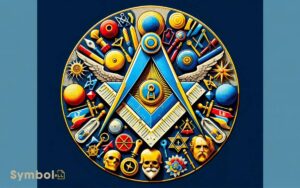What Does Gold Color Symbolize? Wealth and Prosperity!
You’re exploring the symbolism of gold, a hue imbued with layers of meaning across cultures. It universally signifies wealth and prosperity, highlighting high social status and prestige.
Beyond material wealth, gold carries divine connotations, representing purity and a direct link to the divine. It embodies eternal beauty and radiance, encapsulating unmatched allure and metaphorical immortality.
Victory and triumph are also within its purview, celebrating achievements and the overcoming of obstacles. Additionally, gold denotes wisdom and enlightenment, guiding towards clarity.
This rich tapestry of meanings showcases gold’s multifaceted nature, steeped in history and cultural significance. Uncover more, and you’ll see gold’s influence extends even further.

Key Takeaway
Symbol of Wealth
Throughout history, gold has universally been a potent symbol of wealth, signifying not just material prosperity but also social status and power.
You’ll find that across cultures, gold’s intrinsic value and its enduring, non-tarnishing luster have made it a coveted material for trade, ornamentation, and as a standard for currency.
Analyzing its role, you observe that societies have consistently equated gold with the highest forms of wealth, not merely regarding physical assets but as a manifestation of achievement and prestige.
This isn’t just a superficial attraction; it’s deeply entwined in human history and psychology.
Gold’s rarity and beauty have made it a benchmark for wealth, a tangible representation of success and influence that transcends language and geography, embedding itself within the fabric of societal values and aspirations.
Divine Connection
Beyond its representation of material wealth and social prestige, gold also embodies a profound divine connection, revered in various cultures as a symbol of the divine or spiritual domain.
| Culture | Symbolism | Contextual Significance |
|---|---|---|
| Ancient Egypt | Sun and gods | Gold’s radiance likened to the sun’s life-giving energy, symbolizing eternal divinity. |
| Christianity | Purity and divinity | Used extensively in religious icons and sanctuaries to signify a heavenly sphere. |
| Hinduism | Spiritual purity | Gold is considered sacred, used in temples and rituals to honor deities and spirituality. |
Analyzing these cultural contexts, it’s evident gold’s luster isn’t just material but a beacon of divine connection, transcending physical wealth to embody spiritual wealth and purity across different belief systems.
Eternal Beauty
Beyond its spiritual and material significance, gold also captures the essence of eternal beauty, admired across cultures for its timeless allure and enduring radiance. This fascination isn’t merely superficial; it’s deeply embedded in human history and psychology.
Cultures around the world have long associated gold with the idea of perpetual beauty, unmarred by time or decay.
This perception stems from gold’s physical qualities its luster doesn’t tarnish, reflecting a metaphorical immortality.
In art and architecture, gold has been used to depict figures of unmatched beauty, suggesting an ideal that transcends the ordinary.
Analyzing this through an ethnographic lens, you’ll notice that societies value gold not just for its appearance, but for its ability to embody the concept of beauty that lasts beyond the temporal domain, creating a bridge between the tangible and the eternal.
Triumph and Victory
Building on the idea of eternal beauty, gold’s role in symbolizing triumph and victory further cements its significance in human culture, highlighting its power to represent not only timeless allure but also success and achievement.
Throughout history, gold has adorned victors, from Olympic champions crowned with laurel wreaths to military leaders bestowed with medallions.
This tradition underscores a universal belief in gold’s ability to embody the pinnacle of effort and conquest.
Cultures across the globe have esteemed gold as a reward for surpassing challenges, signaling not just personal valor but also communal pride.
Analyzing this from an ethnographic perspective, it’s evident that gold transcends mere decoration; it’s a marker of societal values, celebrating those who rise above, symbolizing not just a moment of triumph but a legacy of victory.
Wisdom and Clarity
In many cultures, gold symbolizes not just wealth but age-old wisdom, embodying the culmination of knowledge passed down through generations.
You find that the pursuit of clarity often aligns with gold’s luminosity, suggesting enlightenment lies in understanding’s pure, unclouded form.
This color’s association with the path to enlightenment underscores a universal quest for insight, guiding societies toward a deeper comprehension of the world around them.
Age-Old Wisdom
Gold’s luminous hue has long been a symbol of wisdom and clarity, guiding civilizations through the annals of history with its enduring glow.
This association isn’t merely superficial; it’s deeply embedded in the cultural fabric of societies worldwide.
In ancient Egypt, gold was believed to possess divine qualities, embodying the sun’s power and the pharaohs’ eternal wisdom.
Similarly, in Greek mythology, golden objects were often attributed to the gods, signifying not only wealth but profound insight and judgment.
This age-old connection between gold and wisdom transcends geographical boundaries, reflecting a universal acknowledgment of its value beyond the material.
It symbolizes a quest for truth, an acknowledgment of the profound and often elusive insights that guide human understanding and progress.
Pursuit of Clarity
The pursuit of clarity, deeply interwoven with wisdom, drives societies to explore beyond the superficial, embedding gold’s symbolism in cultural narratives as a beacon of enlightenment.
This quest isn’t merely a philosophical endeavor; it’s a tangible reflection of values and ideologies, manifesting in rituals, art, and educational systems around the globe.
Gold, as a symbol, transcends its physical value, representing a clarity of thought and purpose that societies endeavor for.
- Cultural rituals: Gold often appears in ceremonies that mark significant life events, symbolizing a clear passage through life’s stages.
- Artistic expressions: Artists use gold to convey messages of enlightenment and insight, guiding viewers towards a deeper understanding.
- Educational symbols: Institutions adopt gold in symbols and emblems, highlighting the pursuit of knowledge and clarity.
Enlightenments Golden Path
Starting on enlightenment’s golden path reveals how societies utilize wisdom and clarity, using gold as a profound symbol to navigate through complexities of knowledge and understanding.
You’ll find that cultures around the globe have long associated gold with insight and enlightenment, embodying not just wealth but the pursuit of a deeper understanding.
This isn’t just about material value; it’s an ethnographic marker of how civilizations value the pursuit of knowledge.
Through rituals, art, and literature, gold’s luminosity symbolizes the light of knowledge cutting through ignorance’s darkness.
It’s a journey towards enlightenment, where wisdom isn’t just acquired but is deeply cherished. In this scenario, gold doesn’t just decorate; it enlightens, guiding you towards clarity and wisdom in a world rife with uncertainties.
Optimism and Happiness
You’ll find that gold’s radiance naturally elevates your mood, acting as a beacon of optimism in various cultural contexts. Its positive energy influence isn’t just anecdotal; communities around the world have historically associated gold with joy and prosperity.
This universal sentiment reflects gold’s unique ability to inspire a sense of happiness and forward-looking optimism.
Brightening Mood Effects
Gold color, often associated with the sun, naturally elevates your mood, instilling feelings of optimism and happiness.
This vibrant hue has a profound effect on the human psyche, tapping into deep-seated associations with wealth, success, and warmth.
Its impact on mood isn’t just a matter of personal feeling; it’s deeply rooted in human culture and history, reflecting the brightness and positivity that gold has symbolized across civilizations.
- Historical significance: Gold has been a symbol of prosperity and divine favor in many cultures, influencing mood positively.
- Psychological impact: The color gold triggers a sense of well-being and joy, enhancing emotional health.
- Cultural associations: In various traditions, gold represents the highest achievements and happiness, reinforcing its mood-brightening effects.
In understanding the mood-enhancing properties of gold, you’re tapping into a rich tradition of optimism and happiness that transcends mere color perception.
Positive Energy Influence
Radiating positive energy, gold’s color not only enhances optimism but also cultivates a sense of happiness, deeply influencing our emotional and psychological state.
Historically and culturally, gold has been a symbol of purity, success, and brilliance across civilizations. Its bright hue is thought to inject a burst of energy and motivation into our lives, encouraging a more positive outlook. This radiant metal has also been a cornerstone of wealth and status, signifying prosperity and endurance throughout history. When compared to other metals, such as copper, gold’s allure often lies in its unwavering luster and natural elegance. Interestingly, exploring the color copper meaning and symbolism reveals its own earthy warmth and grounding qualities, contrasting yet complementing gold’s more luminous and inspiring characteristics.
This isn’t merely a modern interpretation; ancient societies adorned their most important artifacts and temples in gold, believing in its power to connect them to divine energy and prosperity.
Such historical contexts reflect not just an aesthetic preference but a profound belief in gold’s capacity to influence mood and mindset.
You’ll find that its presence in your environment can subtly shift your perspective, promoting a brighter, more optimistic view of the world around you.
Luxury and Exclusivity
In the domain of luxury, the color gold stands as a universal symbol of exclusivity and opulence, setting a standard that transcends cultures and epochs. Its lustrous sheen signifies not just wealth but a distinguished status that separates the ordinary from the extraordinary.
When you encounter gold in any form, be it in fashion, architecture, or personal adornments, you’re witnessing a narrative of affluence that has been carefully crafted over millennia.
- Timeless Appeal: Gold’s enduring value and appeal make it a preferred choice for heirlooms, denoting a legacy that surpasses fleeting trends.
- Craftsmanship and Quality: Objects adorned with gold often require meticulous craftsmanship, reflecting a commitment to excellence.
- Cultural Significance: Across civilizations, gold has marked celebrations, achievements, and milestones, embedding itself deeply in the tapestry of human history.
Power and Influence
Throughout history, societies have wielded gold as a potent symbol of authority and sway, underscoring its role not just in economic wealth but also in the consolidation of power.
You see, in the tapestry of human culture, gold hasn’t merely been a passive marker of affluence; it’s actively shaped the dynamics of leadership and control. Its unmistakable sheen signals a command of resources, a physical manifest of one’s ability to influence and direct the course of events.
From the crowns of monarchs to the halls of governmental power, gold’s presence has been an unspoken language of dominance. This isn’t mere coincidence. It’s a calculated display, a strategy that leverages human psychology.
Gold’s brilliance doesn’t just catch the eye—it captures minds, compelling allegiance, respect, and sometimes even awe, anchoring its status as a universal emblem of power and influence.
Conclusion
In the tapestry of human culture, gold weaves a thread of opulence and transcendence, shimmering with the promise of wealth and the divine. It’s a beacon of triumph, a mirror of eternal beauty, and a sage whispering age-old wisdom.
In its glow, you find a wellspring of optimism, a touchstone of luxury, and a scepter of power. Gold doesn’t just decorate our world; it defines the contours of our aspirations and dreams, crowning our achievements with its lustrous allure.






